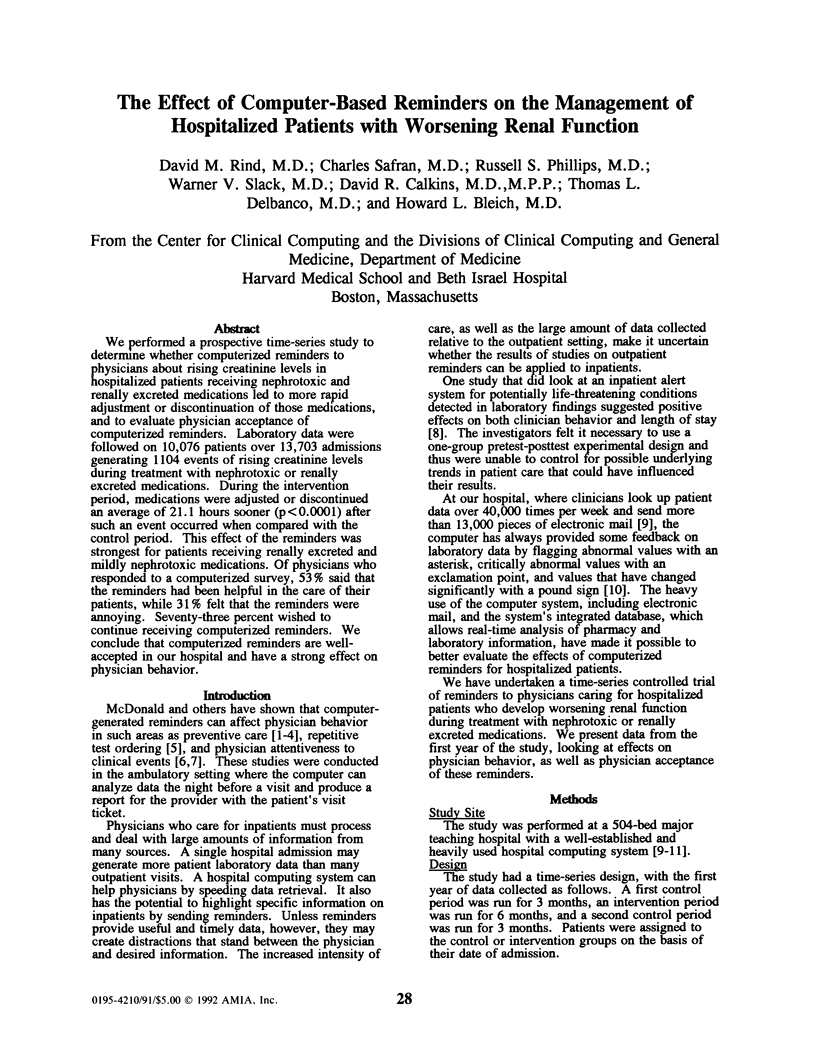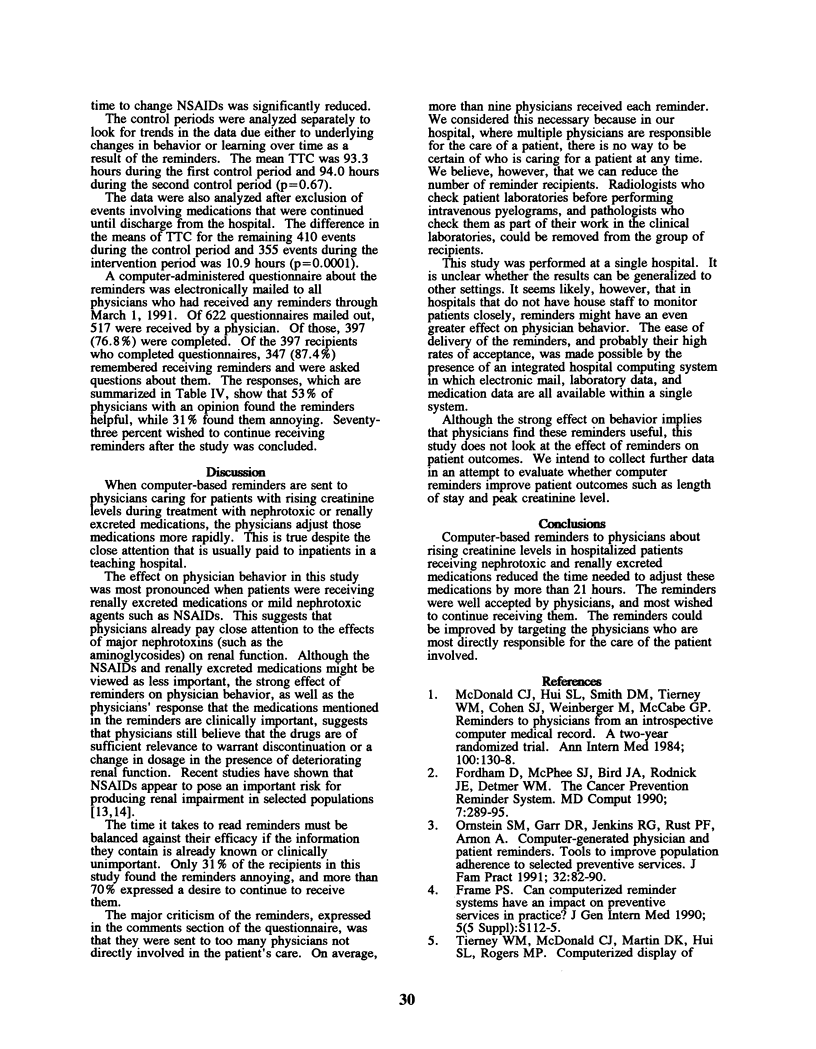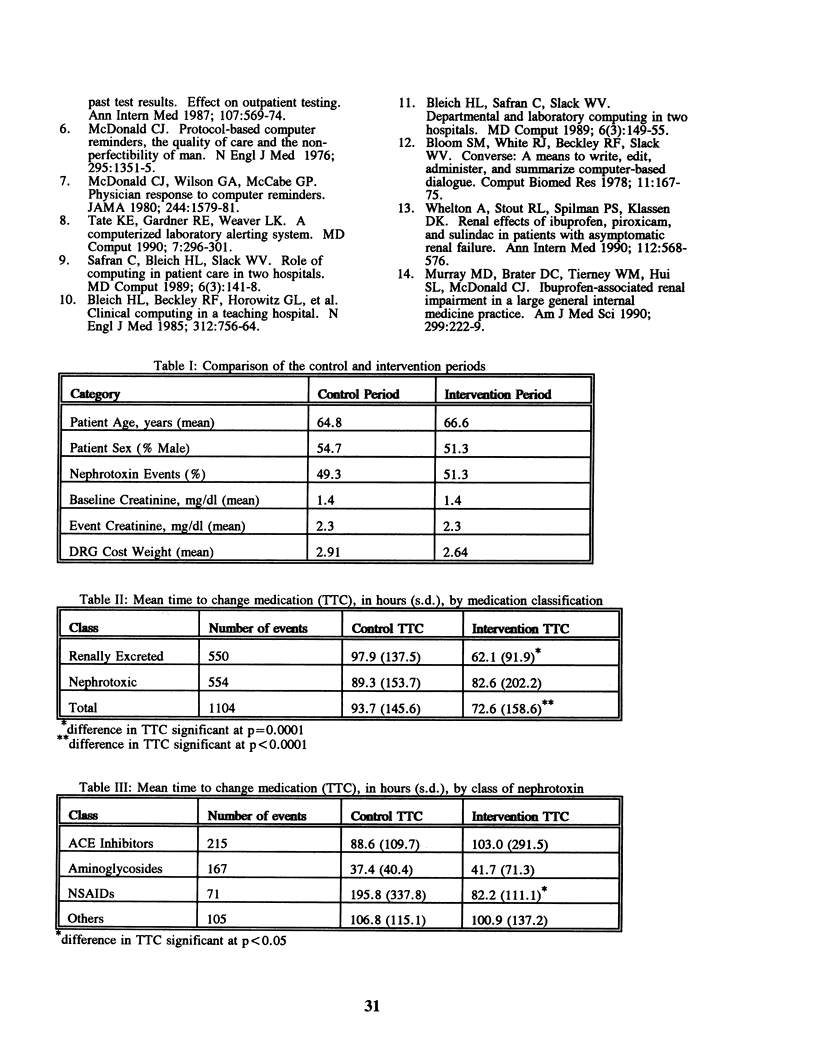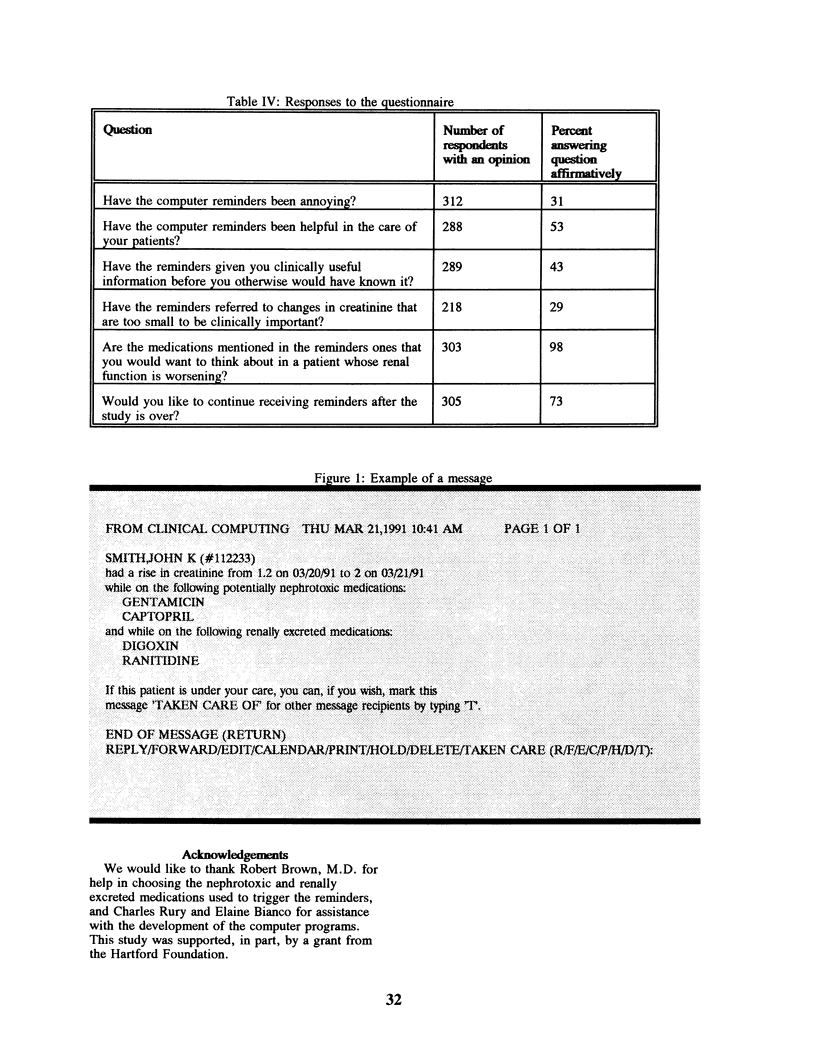Abstract
We performed a prospective time-series study to determine whether computerized reminders to physicians about rising creatinine levels in hospitalized patients receiving nephrotoxic and renally excreted medications led to more rapid adjustment or discontinuation of those medications, and to evaluate physician acceptance of computerized reminders. Laboratory data were followed on 10,076 patients over 13,703 admissions generating 1104 events of rising creatinine levels during treatment with nephrotoxic or renally excreted medications. During the intervention period, medications were adjusted or discontinued an average of 21.1 hours sooner (p less than 0.0001) after such an event occurred when compared with the control period. This effect of the reminders was strongest for patients receiving renally excreted and mildly nephrotoxic medications. Of physicians who responded to a computerized survey, 53% said that the reminders had been helpful in the care of their patients, while 31% felt that the reminders were annoying. Seventy-three percent wished to continue receiving computerized reminders. We conclude that computerized reminders are well-accepted in our hospital and have a strong effect on physician behavior.
Full text
PDF




Selected References
These references are in PubMed. This may not be the complete list of references from this article.
- Bleich H. L., Beckley R. F., Horowitz G. L., Jackson J. D., Moody E. S., Franklin C., Goodman S. R., McKay M. W., Pope R. A., Walden T. Clinical computing in a teaching hospital. N Engl J Med. 1985 Mar 21;312(12):756–764. doi: 10.1056/NEJM198503213121205. [DOI] [PubMed] [Google Scholar]
- Bleich H. L., Safran C., Slack W. V. Departmental and laboratory computing in two hospitals. MD Comput. 1989 May-Jun;6(3):149–155. [PubMed] [Google Scholar]
- Bloom S. M., White R. J., Beckley R. F., Slack W. V. Converse: a means to write, edit, administer, and summarize computer-based dialogue. Comput Biomed Res. 1978 Apr;11(2):167–175. doi: 10.1016/0010-4809(78)90028-9. [DOI] [PubMed] [Google Scholar]
- Fordham D., McPhee S. J., Bird J. A., Rodnick J. E., Detmer W. M. The Cancer Prevention Reminder System. MD Comput. 1990 Sep-Oct;7(5):289–295. [PubMed] [Google Scholar]
- Frame P. S. Can computerized reminder systems have an impact on preventive services in practice? J Gen Intern Med. 1990 Sep-Oct;5(5 Suppl):S112–S115. doi: 10.1007/BF02600855. [DOI] [PubMed] [Google Scholar]
- McDonald C. J., Hui S. L., Smith D. M., Tierney W. M., Cohen S. J., Weinberger M., McCabe G. P. Reminders to physicians from an introspective computer medical record. A two-year randomized trial. Ann Intern Med. 1984 Jan;100(1):130–138. doi: 10.7326/0003-4819-100-1-130. [DOI] [PubMed] [Google Scholar]
- McDonald C. J. Protocol-based computer reminders, the quality of care and the non-perfectability of man. N Engl J Med. 1976 Dec 9;295(24):1351–1355. doi: 10.1056/NEJM197612092952405. [DOI] [PubMed] [Google Scholar]
- McDonald C. J., Wilson G. A., McCabe G. P., Jr Physician response to computer reminders. JAMA. 1980 Oct 3;244(14):1579–1581. [PubMed] [Google Scholar]
- Murray M. D., Brater D. C., Tierney W. M., Hui S. L., McDonald C. J. Ibuprofen-associated renal impairment in a large general internal medicine practice. Am J Med Sci. 1990 Apr;299(4):222–229. doi: 10.1097/00000441-199004000-00002. [DOI] [PubMed] [Google Scholar]
- Ornstein S. M., Garr D. R., Jenkins R. G., Rust P. F., Arnon A. Computer-generated physician and patient reminders. Tools to improve population adherence to selected preventive services. J Fam Pract. 1991 Jan;32(1):82–90. [PubMed] [Google Scholar]
- Safran C., Slack W. V., Bleich H. L. Role of computing in patient care in two hospitals. MD Comput. 1989 May-Jun;6(3):141–148. [PubMed] [Google Scholar]
- Tate K. E., Gardner R. M., Weaver L. K. A computerized laboratory alerting system. MD Comput. 1990 Sep-Oct;7(5):296–301. [PubMed] [Google Scholar]
- Tierney W. M., McDonald C. J., Martin D. K., Rogers M. P. Computerized display of past test results. Effect on outpatient testing. Ann Intern Med. 1987 Oct;107(4):569–574. doi: 10.7326/0003-4819-107-4-569. [DOI] [PubMed] [Google Scholar]
- Whelton A., Stout R. L., Spilman P. S., Klassen D. K. Renal effects of ibuprofen, piroxicam, and sulindac in patients with asymptomatic renal failure. A prospective, randomized, crossover comparison. Ann Intern Med. 1990 Apr 15;112(8):568–576. doi: 10.7326/0003-4819-112-8-568. [DOI] [PubMed] [Google Scholar]


